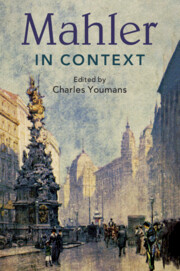Book contents
- Mahler in Context
- Composers in Context
- Mahler in Context
- Copyright page
- Dedication
- Contents
- Figures
- Music Examples
- Notes on Contributors
- Preface and Acknowledgments
- Abbreviations
- Part I Formation
- Part II Performance
- Part III Creation
- Chapter 12 The Composer “Goes to Press”
- Chapter 13 Mahler and Program Music
- Chapter 14 Intertextuality in Mahler
- Chapter 15 The Symphony, 1870–1911
- Chapter 16 Mahler and the Visual Arts of His Time
- Chapter 17 Mahler and Modernism
- Chapter 18 Reception in Vienna
- Chapter 19 Mahler’s Press from London to Los Angeles
- Part IV Mind, Body, Spirit
- Part V Influence
- Further Reading
- Index
Chapter 14 - Intertextuality in Mahler
from Part III - Creation
Published online by Cambridge University Press: 18 December 2020
- Mahler in Context
- Composers in Context
- Mahler in Context
- Copyright page
- Dedication
- Contents
- Figures
- Music Examples
- Notes on Contributors
- Preface and Acknowledgments
- Abbreviations
- Part I Formation
- Part II Performance
- Part III Creation
- Chapter 12 The Composer “Goes to Press”
- Chapter 13 Mahler and Program Music
- Chapter 14 Intertextuality in Mahler
- Chapter 15 The Symphony, 1870–1911
- Chapter 16 Mahler and the Visual Arts of His Time
- Chapter 17 Mahler and Modernism
- Chapter 18 Reception in Vienna
- Chapter 19 Mahler’s Press from London to Los Angeles
- Part IV Mind, Body, Spirit
- Part V Influence
- Further Reading
- Index
Summary
Much of the difficulty encountered by Mahler’s compositions during his lifetime can be attributed to their referential qualities: references, allusions, quotations, or borrowings from the widest varieties of music, from popular (“lowbrow”) military marches or ländlers to cultivated (“highbrow”) compositions such as Brahms’s, Tchaikovsky’s, or Wagner’s. That this propensity embodied modernist impulses has become increasingly clear in the intervening century, as the problematized nature of originality across the various arts ca. 1900 has received critical attention. A closer look at the history and evolving meaning of the term “intertextuality” here advances that process, by highlighting the differences between older formalist interpretive traditions and “translinguistic” practices, which recognize that (in the words of Julia Kristeva) “any text constitutes itself as a mosaic of quotations, any text is an absorption and transformation of another text.” Paradoxically, tactics for discovering new and relevant intertexts illuminate constructions of meaning that are unique to Mahler’s works.
- Type
- Chapter
- Information
- Mahler in Context , pp. 118 - 126Publisher: Cambridge University PressPrint publication year: 2020



